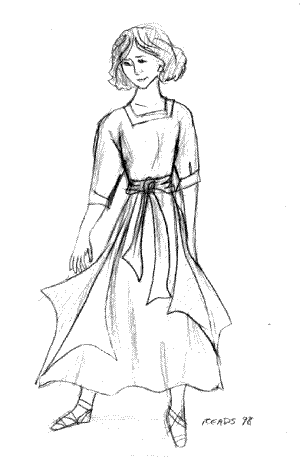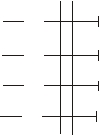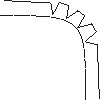Making the Mary Dress
created by Regina Schmiedicke and Catherine Fournier

The History of the Dress
This dress was developed as a result of a conversation I had with my then-fiance Andrew. At the time, I was dressing in homemade calico empire-waist dresses, which he found unattractive.
When I asked him how I should dress, he said, "Like the Blessed Mother."
I had a length of grey rayon material that I was considering for a dress. Since Andrew seemed so insistent on my dressing like the Virgin Mary, I thought, "What the heck." I cut a hole in the middle of the material, draped it over myself like a poncho and tied it with a sash.
"There," I said, "is this how you want me to dress?"
("Like someone in a Christmas pageant?" I thought to myself.)
To my confoundment, his eyes lit up. He said, "Yes, exactly like that." "Ho boy," I thought, and resigned myself to truly counter-cultural dressing.
"But I can't wear it like this," I explained, showing him the openings at the sides. "So sew it up," he suggested.
I was reluctant to simply sew a big bag with a hole in the top, so I took off the material, folded it in half with the neck-hole at the top, and laid it out on the floor. I thought, "Well, I'll angle the material a bit." But I was hesitant to cut it. So I marked the material with chalk, drawing an angle to the skirt and a large tapered sleeve. I felt as though I were making a simple angel costume for a first-grade Christmas pageant.
Then I sewed on my lines, and began to cut off the 'spare' material, starting at the under-the-arm seam. Something (a guardian angel?) made me stop there and try on the dress again for Andrew's scrutiny. The folds from the extra section hung down along the sides of the skirt.
"These will be cut off," I explained to him, holding out the folds. "Hey, those look neat," he said. "Kind of like wings. Why don't you keep it that way?"
And that, in a nutshell, is how it all began.
I later altered the pattern when I began nursing to make a wide-armed jumper instead of a dress. But the dress works well with either. This is a pattern in process, and there are several adjustments possible that only become apparent after you've worn the dress a while ' having to do with stress points. I'll mention these in the course of the directions.
The first Mary dress I made served as my Sunday and formal dress for a long time, and I was very happy with it. But when we had our first child, all of my non-nursing dresses became obsolete. To solve this problem, I cut off the sleeves of my Mary Dress to make a jumper with armholes wide enough to allow me to nurse (either by using a regular T-shirt, a shirt with a slash cut down the middle (hidden by the jumper front) or a button-down top with several buttons opened). When I needed some new everyday dresses, I decided to make myself five Mary jumpers in the liturgical colours (green, blue, red, pink (substituted for white) and purple). I'm still wearing them - I wear one as I type this - and have found them most satisfactory garments.
The Mary Dress and Jumper are of the style called "unconstructed" by fashion designers. They don't have many seams, and rely on sashing (wearing a belt of some kind) for their shape, as opposed to tucks, princess seams, shoulder pads, and the like.
They resemble a "Little House on the Prairie" calico dress very little. There are no puffed sleeves, gathered skirts, fitted armholes, buttons, or ruffles. If a prairie dress is "your style," you might not like a Mary Dress. However, if you tend to wear more "modern" styled clothes, the Mary Dress and Jumper might be the right match for you. It resembles a cross between a medieval gown and the clothes of first-century Palestine. Incidentally, whenever I pass people from the Middle East or India while wearing a Mary dress, I always receive happy waves from them. They assume I'm a countrywoman!
Wearing the Dress
The standard way to wear the dress is with a sash or a belt around the waist. Large triangular shawls also make interesting sashes. So do linked metal belts or macram' ropes (gives a semi-Grecian look).
With a formal 60" wide dress, there are some interesting variations for different looks. Tie the wings together in the front for a wrapped look. Tying them in the back gives a graceful "bustled" sort of appearance. Experiment with tucking all or two of the wings in the sash for different looks. It's wonderfully versatile.
Sometimes the Mary Dress is comfortable worn without a sash - when you're lounging around the house or are nine months pregnant. When I am pregnant, I've found an appealing way to wear this dress is to cinch in the back with a dress cinch so that it smoothly covers my pregnant tummy in an attractive way.
What You Need (Basic Sewing Instructions)
Recommended Fabrics:
Soft, drape-able fabrics such as rayon, cotton or cotton blend knits, soft linen, chiffon. Look for fabrics with identical or similar right and wrong sides .Also suitable: possibly cotton broadcloth, silk, and brocade. (A brocade dress should be lined with the same fabric or with a contrasting material.) Avoid fabrics with nap, such as corduroy or velvet. Also avoid large patterns, stripes or plaid. Solid colours work best, though a large ethic print may be suitable, especially if the print shows on both sides of the fabric.
Notions:
12" cotton broadcloth or calico for interfacing, seam tape, thread
Tools:
Long dressmakers pins, scissors, tape measure, yardstick or straight-edge, chalk, iron and ironing board, full-length mirror or another pair of eyes, four-lines-to-the-inch graph paper (to design your own neckline)
Sewing Terms
| Baste - a temporary fastening,
usually of long hand or machine stitches Pin: - a temporary fastening of pins inserted at right angles to the fabric edge, to hold pieces together while stitching. |
 |
Clip - small, short cuts in the seam
allowance at right angles to the seam, to allow
the fabric to move and fold along the seam line,
usually done on a convex curve Notch - small triangular notches cut into the seam allowance, in the same manner as clipping, usually done on a concave curve |
 |
| Seam - line of stitching holding two
or more pieces of fabric together, usually 5/8"
away from a cut edge. Seam allowance - the fabric between the raw edge and the seam, traditionally 5/8" |
 |
Trim - to cut away excess fabric that would otherwise make a seam too thick or bunchy |
|
| Stay-stitch - stitching within the seam allowance to hold two pieces of fabric together before they are sewn into the garment. With a neckline facing, stay stitching runs at 1/2" |
 |
Top-stitching - machine or hand stitching on the outside or right side of a garment, meant to be seen as a decorative element. Usually 1/2 or 1/4 inch from the finished edge. |
 |
| Hem - the raw, or unfinished edge of
fabric, turned under and sewn to prevent
ravelling and give a neat appearance, can be
done with small invisible stitches, or through
all layers with a machine seam. Selvage - the finished edge along the sides of fabric, formed by the machine that wove the fabric |
|
||
| Right side - the outside of the fabric that will be seen when the garment is worn |
 |
Wrong side - the inside of the fabric, that will not be seen when the garment is worn. |
 |
Designing the Dress in Inches
How Much Fabric?
Dress Length = Height from shoulders to floor ______" x 2
= ____________
Finishing Material = 10 - 12 inches
Nursing Panel = Length from shoulders to below
navel = ________"
Dress Length + Finishing Material + Nursing Panel
= ____"/36 = ____ yards
Neckline Design:
How Wide? (from centre of neck to shoulder) = ______
How Deep? (from shoulder to chest) = _______
Sleeve Design:
Cuff Diameter (comfortable measurement of your arm at the
point where the sleeve ends):________
Sleeve Length (measurement from this point on arm
to arm-pit): _________
For a regular sleeve, increase Cuff Diameter 1"
every 5" of sleeve
For a wider, fuller sleeve, increase Cuff
Diameter 1" every 4" of sleeve
Example:
Cuff Diameter = 12" Sleeve Length = 15"
For a regular sleeve, 15 divided by 5" = 3,
giving a total increase in sleeve width of 3" So the
Sleeve Width at body = 12" + 3" = 15"
For fuller Sleeve, 15 divided by 4" = 3.75,
giving a total increase in sleeve width of 3.75" So the
Sleeve Width at body = 12" + 3.75" = 15.75"
How to Make the Mary Dress
Fabric:
The comfortable and flattering effect of this dress relies on using a soft, draping material. I have made my dresses out of rayon, 100% cotton knit, and most recently, linen. (I also made some out of chiffon for angel costumes, too). I am the most familiar with using cotton knit, having made about six dresses of this material.
The next dress I make will be of 100% cotton broadcloth, because I want to see how a stiffer material works. But I would guess it would make the dress more of a kimono and less of a flowing, Virgin-Mary like look. You might try the dress in silk (hard to find in a wide length) or chiffon for a dressier dress (wear a cotton sheath beneath it), but in general, sturdier materials are best if you intend to wear this dress frequently.
This dress works well as either an everyday or a formal dress, depending on the material. A brocade Mary Dress would be stunning, though you'd need a brocade that wasn't too stiff.
I recommend using material that is 60" wide as opposed to 45" wide. Most calicos are 45" wide. Formal materials like velvet are often 60" wide. You may often find knit materials and rayon in both widths. The wider fabric makes a more pleasingly full garment. Even if you are concerned about more material enhancing a not-too-thin figure, I would still recommend the 60" material. Remember, since the fabric will be draped, not gathered and ruffled, it won't necessarily make you look "fatter." You can make a Mary Dress in 45" wide material, but the wings won't be as long and the skirt won't be as full. Having done both, I still like the wider material for comfort (less danger of ripping seams) and drama (it's more fun to do swing or folk dancing when your skirt is fuller).
As a last note: the Mary dress is designed to be a long dress, ankle or mid-calf length. Your own height will determine how long the dress should be - shorter people look even shorter in a floor length dress, while taller people are better proportioned with a longer dress. The dress really won't work as a knee length or shorter, it's too full and draping to be cut off that short.
How much Fabric?
For the Mary Dress: You will need enough material to fall from your shoulders (overlap your shoulder slightly for seam allowance) to the floor twice. That is, your entire body length (not counting your head) twice. This is your Dress Length.
This should allow for shrinkage and still allow enough material for a narrow matching sash. Then add a generous ten inches for pockets, neck facings, and any extra bias strips. This is your Finishing Material. If you want a wider sash (or a longer one, since cutting out the neckline facing will shorten your sash), get a few more inches of material. To do this calculation, refer to the page entitled: Designing The Dress in Inches.
For a Mary Dress with a nursing panel, additional material is needed. Measure from your shoulder (overlapping your shoulder slightly for seam allowance) to about five inches below your navel. This is your Nursing Panel. Add this measurement to your total. Although the Mary dress itself wastes very little fabric (one of its beauties) if you make a nursing panel, you may have about a foot and a half extra material. You could use this to make a matching outfit for your infant, if you like. I've done this myself with great success.
Pattern:
The Mary dress uses your body measurements to shape the fabric, rather than an anonymous generalized pattern. There are several advantages. The first is not having to mess around with fragile fly-away tissue paper. The second is not having to experiment with an unknown. You can't really "try on" a paper pattern but you can try on the Mary dress every step of the way, before sewing or cutting. Adding extra inches for ease and seam allowances is fairly simple. Finally, you feel innovative and competent sewing without a pattern and can boast, "I don't use patterns," in a very satisfying manner to your friends.
At first, sewing without a pattern will seem a bit strange and awkward. You might be afraid to cut anything, and recheck your measurements over and over! But consecutive sewing of that garment will be far simpler. The construction of the neckline and pockets is easiest with a paper pattern. You can draw one using the instructions further down, or use a pattern piece from another paper pattern, if you like the size and shape.
Procedure for the Basic Mary Dress:
I will give the instructions for the dress first in short form, to give a general idea of the sequence of events, then in more detail. Read these instructions all the way through the first time before doing anything else.
Short Form:
- Prepare the material.
- Measure and cut the Dress Length (see Designing the Dress in Inches for this measurement.)
- Mark the center point for the neck.
- Construct and insert the neckline.
- Draw and baste the arm and side seams.
- Construct and insert the pockets.
- Sew the arm and side seams.
- Finish the dress.
Making the Mary Dress In Detail
After struggling for literally WEEKS! with HTML programming to make the pattern instructions and images look good on screen and paper in various resolutions, various monitor sizes and different browsers with no success, I've given up and created PDF files for the rest of the directions for the Mary Dress. (I'm sure there's someone out there who has a simply and easy solution to this problem, but I couldn't figure it out. Yes, I tried tables.)

Click on the Mary Dress to reach the pattern instructions. If you don't have Adobe Acrobat (necessary to view and print PDF files) click the icon for a free download of the application. It will ask you a few questions about the computer you're using, and then the download only takes a few minutes. (Enough time to go make lunch.)
Return to Fridge Art Page.